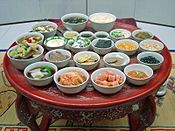- Gochujang
-
Gochujang 
A jar of gochujangKorean name Hangul 고추장 Hanja --醬 Revised Romanization gochujang McCune–Reischauer koch'ujang Gochujang[1] (Korean: 고추장, IPA: [ko.tɕʰu.tɕaŋ]) is a savory and pungent fermented Korean condiment. Traditionally, it has been naturally fermented over years in large earthen pots outdoors, more often on an elevated stone platform, called jangdokdae (장독대) in the backyard. Its HS code is 2103.90.1030.
Contents
History
Gochujang (hot pepper paste) is believed to have been first used in Korea in the late 18th century, after chili was introduced via Japan in the 16th century.[2] According to the Jungbo Sallim geongje (증보산림경제, 1765), gochujang was made by adding powdered red chili peppers and glutinous rice powder to soybean paste, and aging this paste under the sun. This recipe is similar to the recipe used today to make gochujang.[3]
Ingredients
Gochujang's primary ingredients are red chili powder, glutinous rice powder mixed with powdered fermented soybeans, and salt. Major substitutes for the main ingredient, glutinous rice (hangul: 찹쌀), include normal short-grain rice (hangul: 멥쌀), and barley, and less frequently, whole wheat kernels, jujubes, pumpkin, and sweet potato; these ingredients are used to make specialty variations. A small amount of sweetener, such as sugar, syrup, or honey, is also sometimes added. It is a dark, reddish paste with a rich, piquant flavor.
It has been made at home in Korea since the 16th century, after chili peppers were first introduced. The making of gochujang at home began tapering off when commercial production started in the early 1970s and came into the mass market. Now, homemade gochujang can hardly be found.
It is used extensively in Korean cooking, to flavor stews (jjigae) such as gochujang jjigae, marinate meat such as gochujang bulgogi, and as a condiment for naengmyeon and bibimbap.
Gochujang is also used as a base for making other condiments, such as chogochujang (초고추장) and ssamjang (hangul: 쌈장). Chogochujang is a variant of gochujang made from gochujang with added vinegar and other seasonings, such as sugar and sesame seeds. It is usually used as a sauce for hoe and hoedeopbap. Similarly, ssamjang is a mixture of mainly gochujang and doenjang, with chopped onions and other spicy seasonings, and is popular with sangchussahm (hangul: 상추쌈), which is a lettuce wrap of grilled meat, sliced garlic, green chili peppers and other vegetables.
Nutrition and health
Gochujang has traditionally been one of the three indispensable household condiments, along with doenjang and ganjang. Gochujang contains protein, fats, vitamin B2, vitamin C, and carotene.[4]
Use
Gochujang is used in bibimbap and tteokbokki. Gochujang makes dishes spicier (contributed by the capsaicins from the chili), but also somewhat more sweet.
See also
References
- ^ Gochujang is also romanized as gochoojang, gochuzang, gochoozang, or simply "hot bean paste".
- ^ Quantum leap of kimchi
- ^ Common Gochujang Recipe
- ^ Korean Food and Health - Korean Hot Pepper Paste
Hot sauces Adobo • Aji (food) • Ajvar • Bajan pepper sauce • Biber salçası • Blair's Sauces and Snacks • Búfalo • Cholula Hot Sauce • Crystal Hot Sauce • D'Elidas • Dave's Gourmet • Doubanjiang • El Yucateco Chile Habanero • Filfel chuma • Frank's RedHot • Gochujang • Harissa • Huy Fong Foods • Jaew bong • Llajwa • Louisiana Gold Hot Sauce • Louisiana Hot Sauce • Mojito isleño • Mojo (sauce) • Pebre • Pickapeppa sauce • Ro*tel • Sambal • Scorpion Bay Hot Sauce • Shito • Skhug • Sriracha sauce • Tabasco sauce • Tapatío hot sauce • Texas Pete • Trappey's Hot Sauce • Valentina (sauce)
This article is part of a series on Korean cuisine
한국 요리AncillariesBeveragesOtherKimchi Field Museum • Kimchi refrigerator • List of Korean dishes • List of Korean beverages • Korean royal court cuisine Korea portalCategories:
Korea portalCategories:- Fermented foods
- Korean condiments
- Hot sauces
- Korean ingredients
Wikimedia Foundation. 2010.

